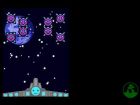DS games have not played a heavy role at this year's E3, but a couple of hidden gems were worth discovering on the show floor. Perhaps the most interesting of these was Rhythm Heaven, the DS version of a cute little GBA game published exclusively in Japan a few years ago under the name Rhythm Tengoku. We don't know if and when this title will be published in North America, but what we played -- and the almost total lack of Japanese text -- make us hope to see it soon on our shores.
Our demo only featured three mini-games, plus two slots for activities not yet unlocked, so we're not sure about the final number of mini-games included. The first step was a short and simple tutorial that explained the basic movements. As the game is completely touch-based, there's no need to tap any button at all, which makes things easier and fun to play. After selecting the left- or right-handed mode, we had to turn the DS vertically, with the touch screen being on the side of the hand players use to write. We were then introduced to the concept of "flick," a basic movement that is probably going to be employed in a variety of mini-games in the final version of the title. Flicking is extremely easy: Players slide the stylus on the touch screen in a fast motion and a coin on the other screen moves accordingly, hitting a frog statue first and then a moving toy car.
Starting on the bottom of the main menu screen, we selected the first mini-game, "Assembly Line." Two square metal pieces moved toward the center of a stylized assembly line in rhythm with the background melody. When the fifth note struck, we had to quickly flick a piston toward the metal pieces, securing them together. It may sound complicated, but it was really easy to understand the idea behind the mini-game and put it into action. The music gave us a pretty clear idea of when to flick the piston, no more and no less than tapping your foot or your finger to a song you like.
The second mini-game was "Chorus," a simple singing activity featuring three of the cutest characters we have seen in a videogame in a long time. Our little character would sing uninterruptedly if left untouched, so we had to press our stylus on the touch screen and leave it there to keep his mouth shut. Following the rhythm of the other two singers, we had to release the stylus when our singer had to do his part harmonizing with the others, and tap again to stop him at the right time. It was especially funny to see the other two singers pulling an upset face when we couldn't stay with the rhythm of the song.
The last mini-game was "Robot Factory," where we were required to fuel robots once they were built on the assembly line. Every action was based on the music: Robots were assembled in three beats, then we had to tap the touch screen at the fourth beat, injecting oil into one. The stylus had to stay on the screen for a certain number of beats, more or less according to the size of the robot we were fueling. Once we understood the concept at the base of each mini-game, everything was easy to perform and absolutely fun. Rhythm Heaven looked and sounded great, thanks to a minimalistic music score composed by the Japanese producer TSUNKU and to a cool graphic style that blends hand-drawn animation with stylized lines and primary colors. Rhythm Heaven doesn't have a North American release date, but we look forward to seeing it again.





